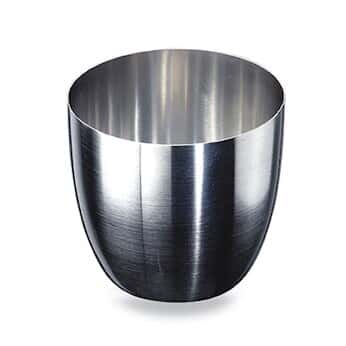Platinum Evaporation Crucible (Pt crucible)
The Platinum Evaporation Crucible is crafted from high-purity platinum (≥99.95%), offering exceptional resistance to high temperatures, chemical corrosion, and oxidation. Designed for precise and consistent performance, it is widely used in semiconductor fabrication, optical coating, laboratory research, and advanced material processing.
Available in a variety of standard and custom sizes, these crucibles ensure uniform thermal conductivity, excellent durability, and minimal contamination during evaporation processes. Platinum crucibles are also available for enhanced strength at elevated temperatures.
Material | Platinum |
Purity | 99.95%-99.99% |
Dimension | Customized |
Density | 21.47g/cm3 |
Surface | Polished, Alkali Cleaning,Chemical Cleaning |
Standard | ASTM |
Certification | ISO9001 |
Description of Platinum melting crucible
A platinum melting crucible is a high-purity container designed to withstand extremely high temperatures, commonly used for melting, alloying, and chemical analysis of metals and oxides. Made from 99.95% or higher purity platinum, it offers excellent resistance to corrosion, oxidation, and chemical attack even under aggressive conditions. The crucible maintains structural stability and minimal contamination risk, making it ideal for laboratory, glassmaking, and semiconductor applications. It is available in various sizes and shapes, often customized to meet specific temperature and process requirements.
Platinum Crucible Specifications
| Chemical Name | Platinum |
Appearance | Silvery white crucible |
Density | 21.47g/cm3 at 20°C |
Assay Percent Range | 99.9% (Metals basis) |
Form | Cylindrical platinum crucible Straight-walled platinum crucible Tapered platinum crucible Platinum boat crucible Platinum crucible with lid Platinum crucible with spout |
Platinum Furnace Crucible Application
A platinum crucible is ideal for precious metal melting due to its high melting point (1,768°C) and resistance to oxidation, ensuring pure, contamination-free results. It is commonly used for gold, silver, platinum, and palladium refining in jewelry, bullion, and industrial applications. The crucible’s durability and non-reactive nature make it perfect for repeated use in furnaces and induction melters.
Platinum Crucible scholar article
Reaction of platinum crucible and melt during PMN-PT crystal growth
Abstract: PMN-PT crystals have been of considerable interest in recent years due to their excellent ferroelectric, piezoelectric, photoelectric properties and promising applications in various electric and electric–optical devices. However, the crucible leakage is usually a fetal limitation during preparation of the crystal. In this work, the PMN-PT crystals were prepared by Bridgman-accelerated crucible rotation technique (ACRT) method. The morphologies of the bottom surface of the PMN-PT crystal and the inner surface of the platinum crucible, in which the crystal grew, were examined by scanning electronic microscope (JSM-840). The local composition was analyzed by EDAX spectrometer attached to the scanning unit. Investigated results indicated that there are evident reaction between the platinum crucible and PbO–MgO–Nb2O5–TiO2 melt during PMN-PT crystal growth, which is the main cause of crucible leakage. Another cause of the crucible leakage is due to the unequally distorted platinum grain boundary.

